When the word “anthurium” echoes through the air, the vivacious Flamingo flower plant, or Anthurium andraeanum, almost certainly springs to mind. Often called the “wax flower,” this plant boasts lustrous spathes that exude a nearly plastic-like appearance.
The Flamingo flower is the focus of this blog. We’ll focus on its care, answer common questions and share interesting facts.
Typically, I focus on the more visually striking foliage anthurium species, such as the Queen Anthurium Warocqueanum or strap leaf anthuriums.
But learning about flamingo flower care helps in understanding other species in the anthurium genus.
Due to its widespread availability and extensive research on its industrial cultivation, a wealth of knowledge is available on this species.
So whether you’re in here to learn only about the flamingo plant or stumbled across them by looking for other anthurium species, you will find something interesting here.
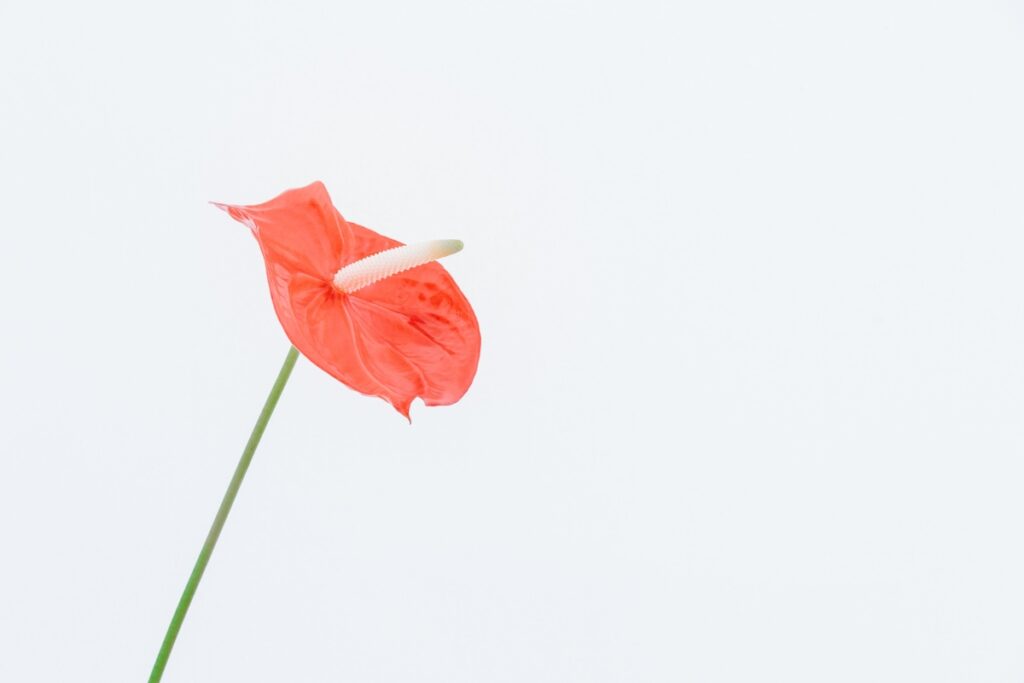
Flamingo Flowers, aka Anthurium Andraeanum
Flamingo flower is a common name for Anthurium andraeanum, a tropical plant species in the aroid family.
But this anthurium plant is more commonly recognized by its evocative monikers: Flamingo Flower, Flamingo Lily, Painter’s Palette, or Tailflower. In Spanish, it’s called “Cresta de gallo,” which means “cockscomb,” a fitting name for the extravagant red inflorescence.
Affectionately called the “wax flower” by some, this anthurium plant owes its nickname to the glossy spathes or shield-like leaves that resemble a carefully sculpted work of art.
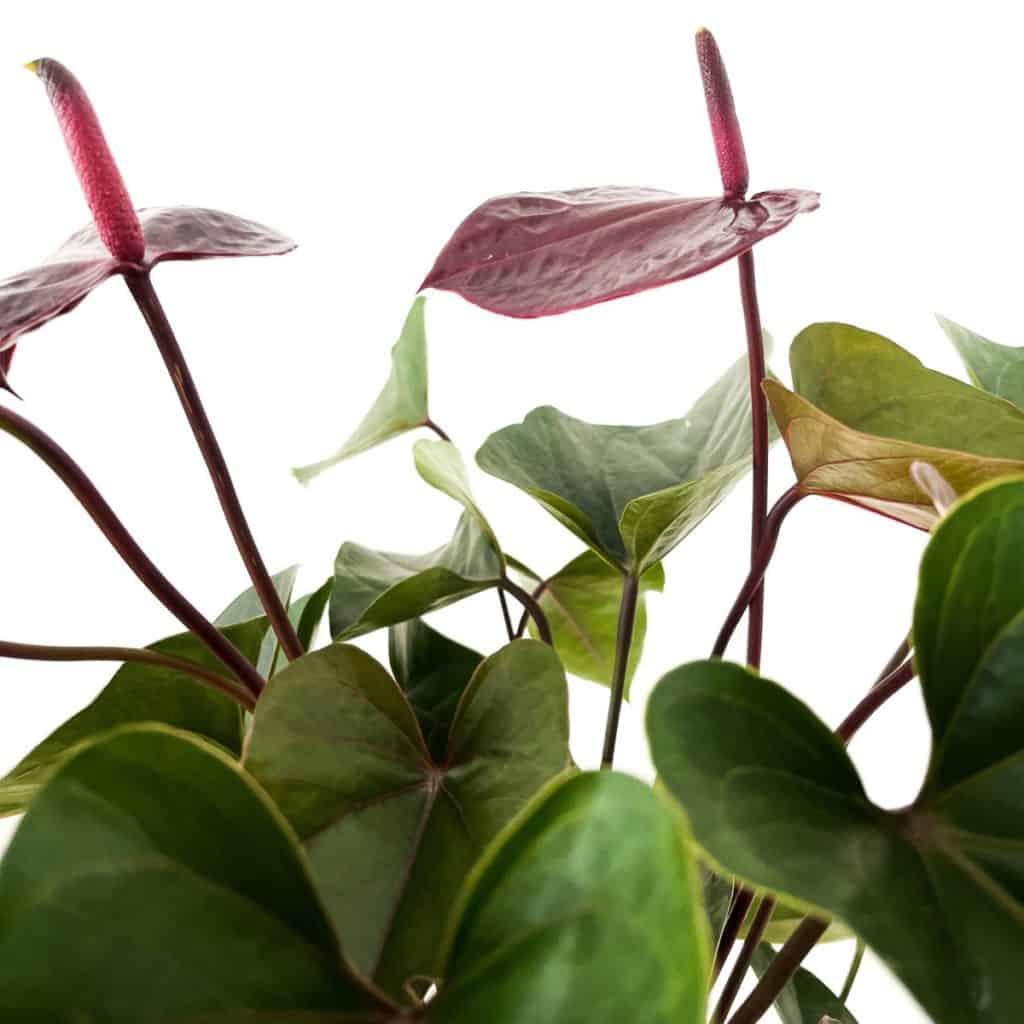
While the most widely recognized flamingo lily boasts vibrant red spathes, these exotic flowers are not limited to a particular hue. Indeed, the dazzling spectrum of the flamingo plant spathes extends far beyond, encompassing an astonishing palette of coral, pink, green, or red colors. They can also be variegated!
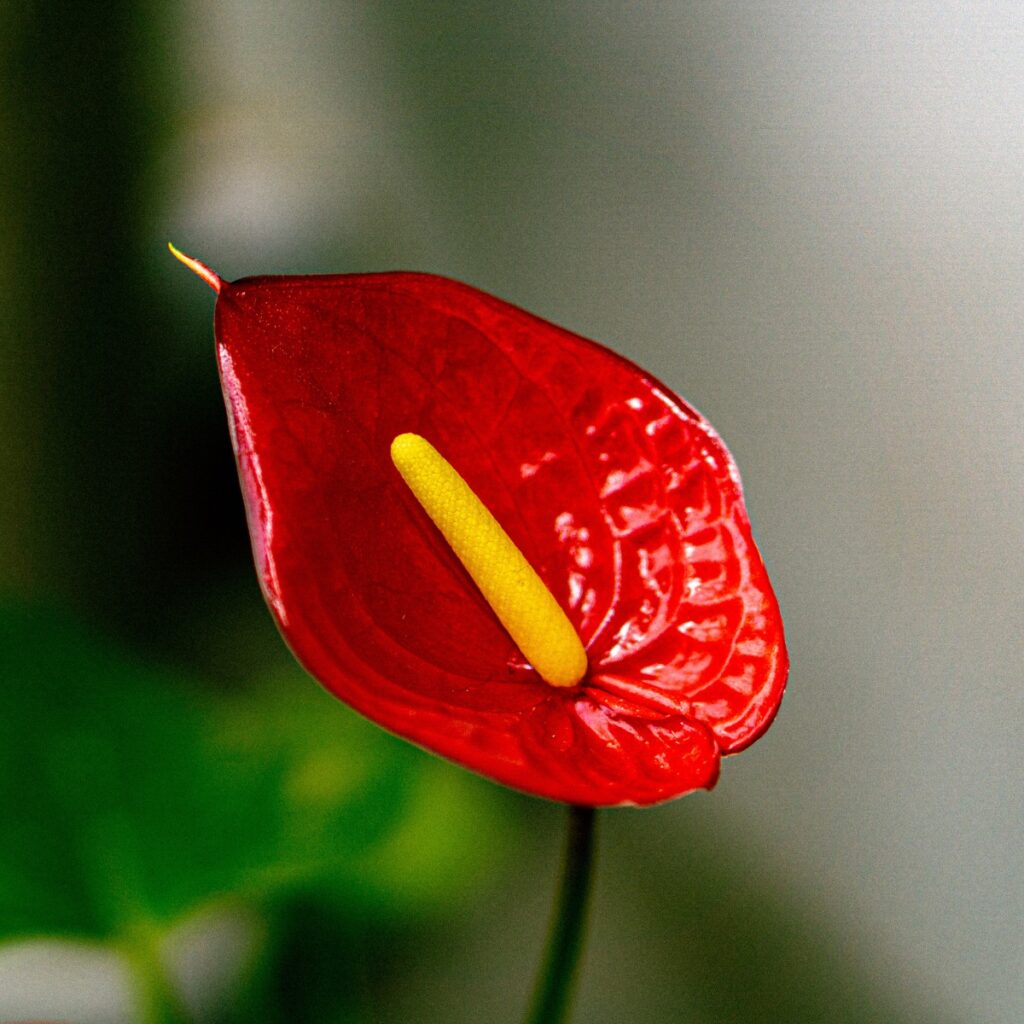
You might be captivated by the magnificent foliage of Anthurium magnificum or the glorious abs of Anthurium veitchii, yet it is difficult to overlook the striking blooms of Anthurium andraeanum.
A brief history of the Flamingo Flower in Cultivation
Anthurium flowers, originally native to the rainforests of Central and South America, have found a home in the lush tropical paradise of Hawaii.
First discovered by Edouard Andre in 1876, these vibrant flowers made their way to Europe before Samuel Mills Damon introduced them to Hawaii in 1889. The anthurium flower industry in Hawaii took off in the 1930s and 40s, with hobbyists growing them in gardens and backyards.
The industry saw significant growth with the discovery of the Ozaki, Nitta, Uniwai, and Marian Seefurth anthurium varieties. The University of Hawaii played a significant role in this development, with Haruyuki Kamemoto establishing the anthurium research program in 1950.
His contributions impacted not only the anthurium industry but also Hawaii’s orchid industry, helping to shape the rich floral landscape of the islands.
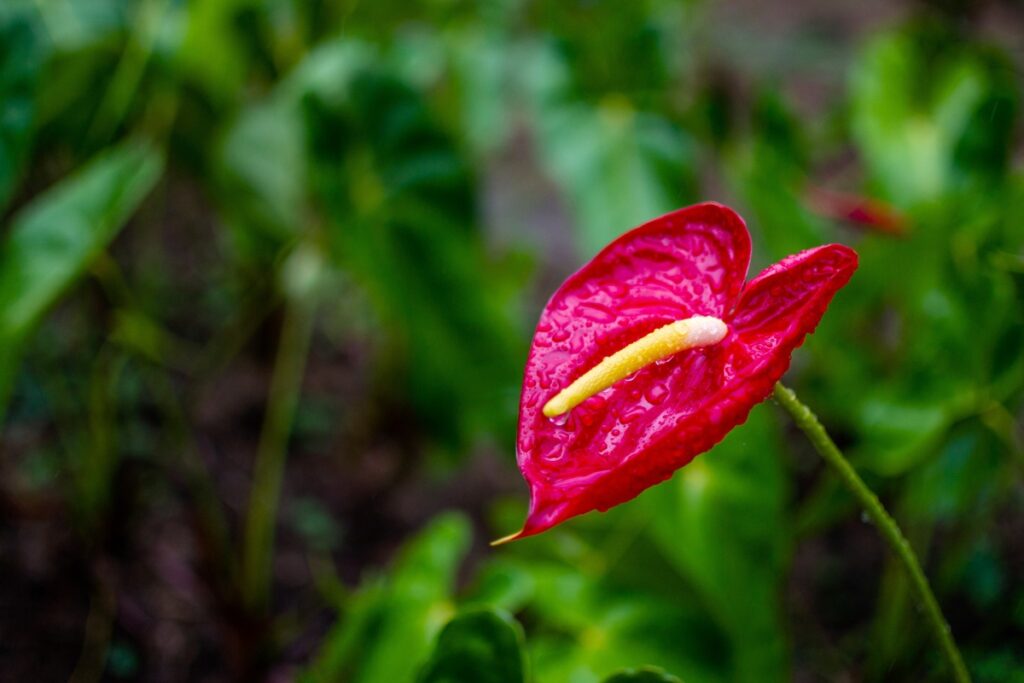
The bright red spathe and one of the most characteristic flamingo flowers are, in fact, the Ozaki cultivar.
Anthurium is the most important cut flower in the Hawaii floriculture industry, a worldwide leader. And it is one of the most widely cultivated plants in horticulture for its cut flowers.
Anthurium andraeanum is the only anthurium species (at least I know of) grown for its flowers, not the foliage.
Anthurium varieties
Anthurium andraeanum is a collective name for anthurium cultivars that are complex hybrids between Anthurium andraeanum Linden and other species in the section Calomystrium.
Take a look at other Anthurium species in the Calomystrium section: Anthurium Recavum & Anthurium Veitchii (King Anthurium). Do you see any resemblance?
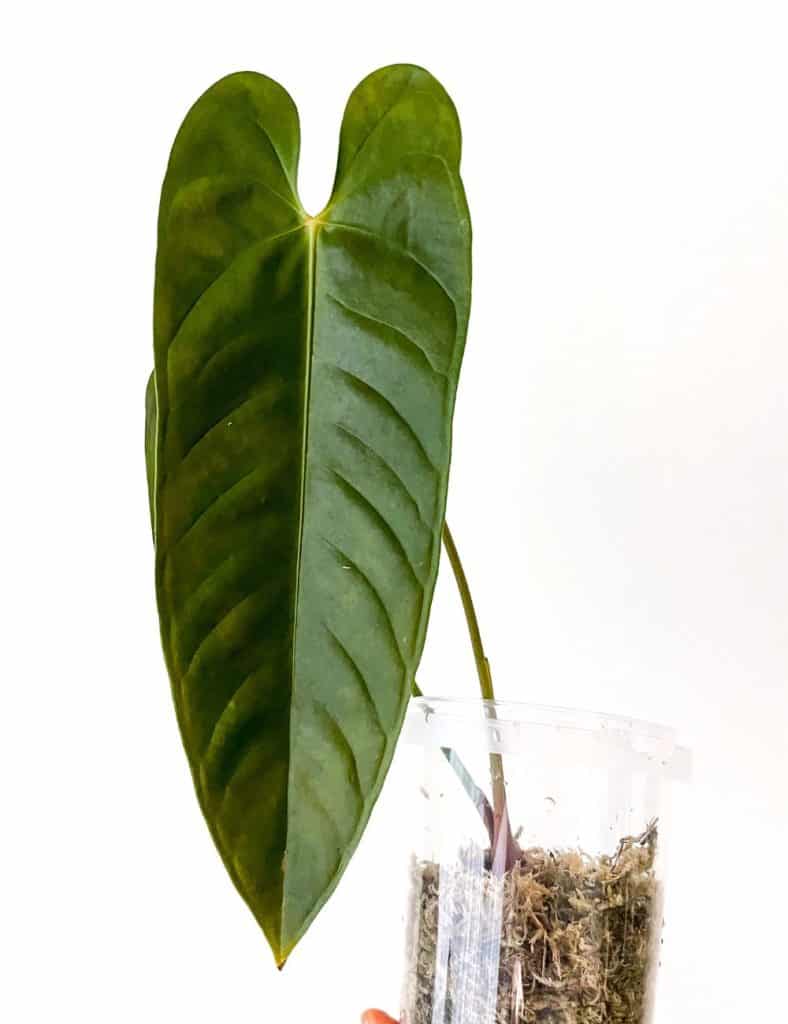
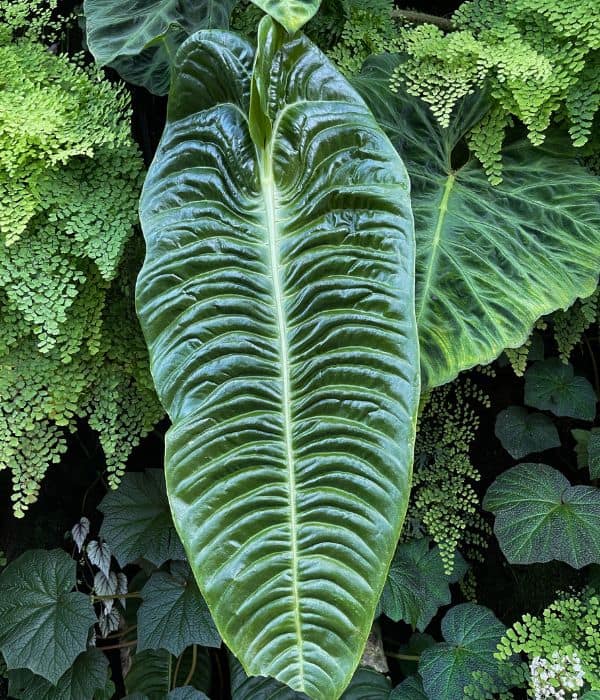
How to care for Flamingo flower
The most critical factors in flamingo flower care come down to light (where you put it), water (how you water it), and fertilizer (what you feed it). If you can get these factors right, you’ll grow anthurium plant like a pro.
Light: Flamingo flower light needs
Flamingo lilies flourish in bright indirect light, essential for their healthy growth and vibrant blooms. Avoid direct sunlight to prevent leaf scorching.
Instead, provide ample bright indirect light (or grow lights) to ensure your anthurium can produce blooms. A sunny window sill with a sheer curtain will ensure bright light avoiding too much direct sunlight.
Common issues: How improper lighting affects anthurium growth
- Reduced or lack of blooms: Insufficient light can lead to poor flowering or a complete absence of blooms. Remember, producing inflorescences requires a lot of energy from the plant, and the energy comes primarily from light. Provide your anthurium with plenty of bright indirect light and often fertilize to see the blooms.
- Leggy or straggly growth: Too little light can cause the plant to stretch towards the light source, resulting in elongated, weak stems and sparse foliage.
- Yellowing leaves: Both too little and too much light can cause the leaves to turn yellow. The plant may not photosynthesize effectively in low light, while direct sunlight can burn the leaves. Also, too much water can cause the leaves to turn yellow and fall off.
- Slow or stunted growth: Insufficient light can limit the plant’s ability to photosynthesize, which may lead to slow or stunted growth.
- Leaf burn or sunburn: Excessive sunlight or direct sun exposure can cause leaf burn or sunburn, resulting in brown or scorched patches on the leaves.
To avoid these issues, ensure your anthurium receives the appropriate bright indirect light for optimal growth and blooming. For an in-depth guide on providing your anthurium with proper light, check out my blog: Anthurium Light Requirements: Everything You Need to Know.
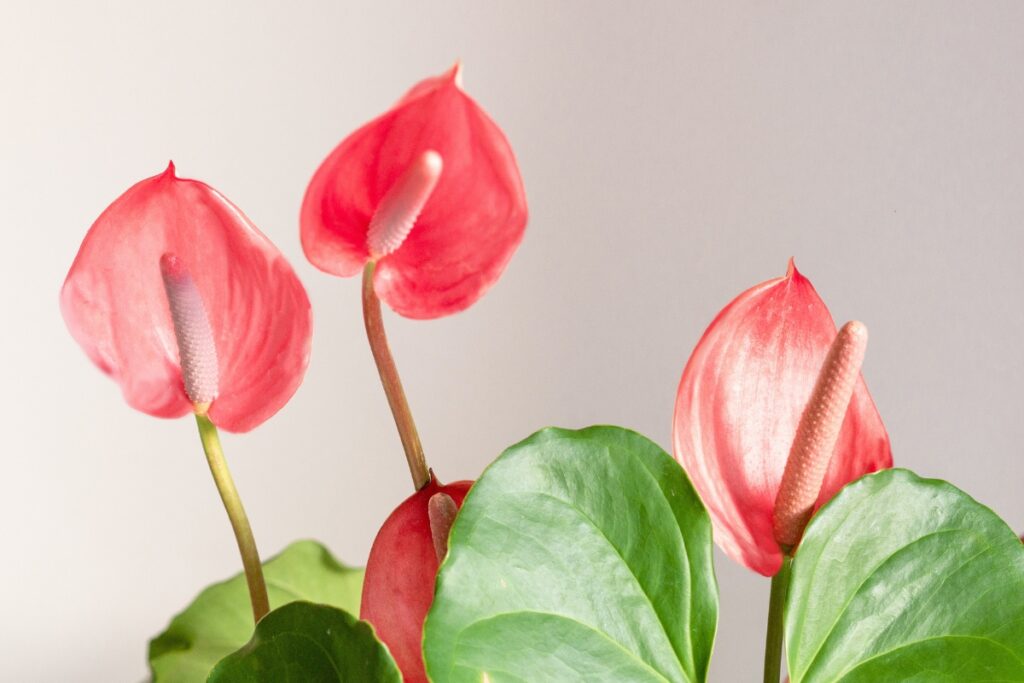
Watering & Humidity: Flamingo Lily water & humidity requirements
Watering requirements for anthuriums are closely tied to the type of potting medium used. Different mediums retain moisture differently, affecting the water’s frequency and amount needed.
To ensure your anthurium stays healthy, monitor the moisture level of your chosen potting mix and adjust your watering routine accordingly. This will help you provide the right water balance for your anthurium’s needs.
For more information, check out my watering guide specifically for anthuriums.
Anthuriums thrive in high-humidity environments, as they originate from tropical rainforests. Ideally, they require humidity levels of around 60-80%, but I don’t think the humidity is that critical to overall growth. Plants are very resilient and can adapt to their environment.
You might be tempted to put your anthurium in the bathroom, which is excellent for providing optimal humidity, but unless your bathroom is well-lit, your flamingo flower will struggle.
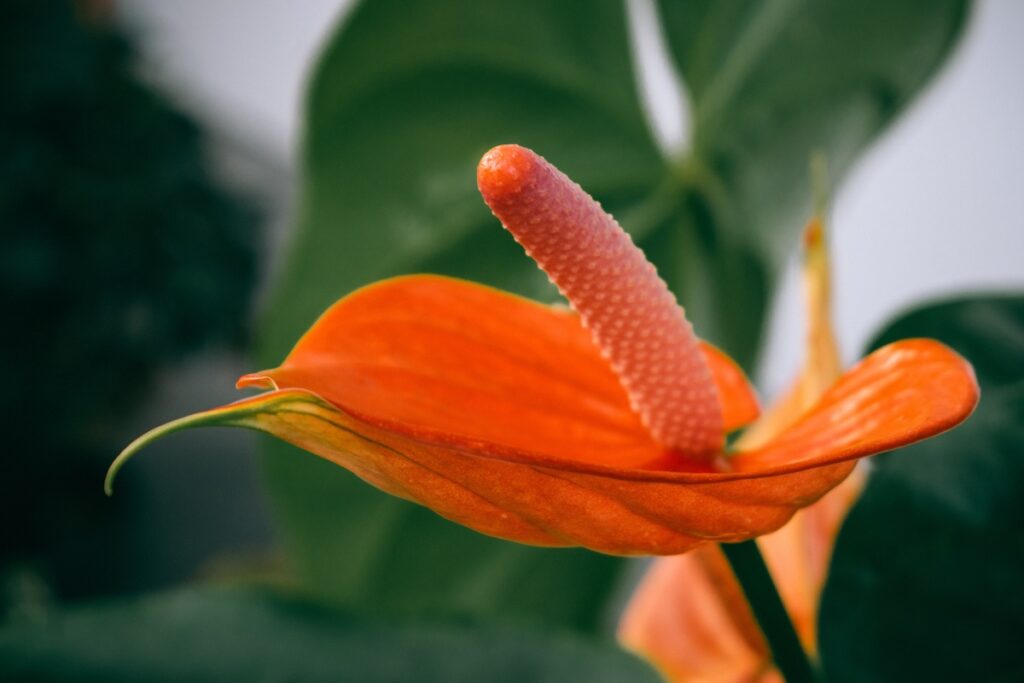
Fertilizer: What to feed your flamingo flower plant
The best fertilizer for anthuriums is a balanced, water-soluble fertilizer. You can’t go wrong with equal parts of nitrogen, phosphorus, and potassium.
But, since we’re talking about Anthurium andraeanum, which you’re growing primarily for its colorful blooms, I’d suggest a high phosphorus fertilizer, so something like 10-20-10 would be good.
I fertilize my anthuriums every 4-6 months with controlled-release fertilizer granules and a weak solution of liquid fertilizer with every watering.
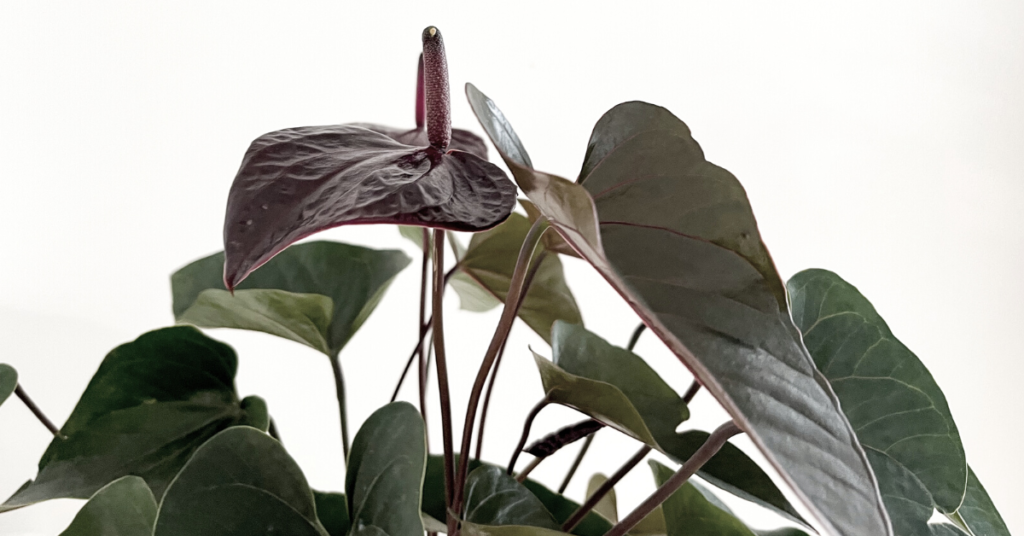
Potting Soil: Is there a perfect soil mix for flamingo lily?
Flamingo flowers grow as epiphytes in the wet mountain forests of Ecuador and Colombia. You can imagine they like a moist but well-draining environment.
Anthurium andraeanum thrives in a chunky, well-draining potting mix that provides the ideal balance of moisture retention and aeration.
This tropical plant requires a growing medium closely mimicking its natural habitat, allowing its roots to breathe while retaining sufficient water.
I found the perfect blend to consist of orchid bark, perlite, coco coir, and a bit of leca in the mix, creating a porous and airy structure that supports the plant’s overall health and growth. Some growers use peat moss, but I don’t like to use it as it makes the potting soil too water retentive.
For a more scientific explanation, check out this study I summarized below.
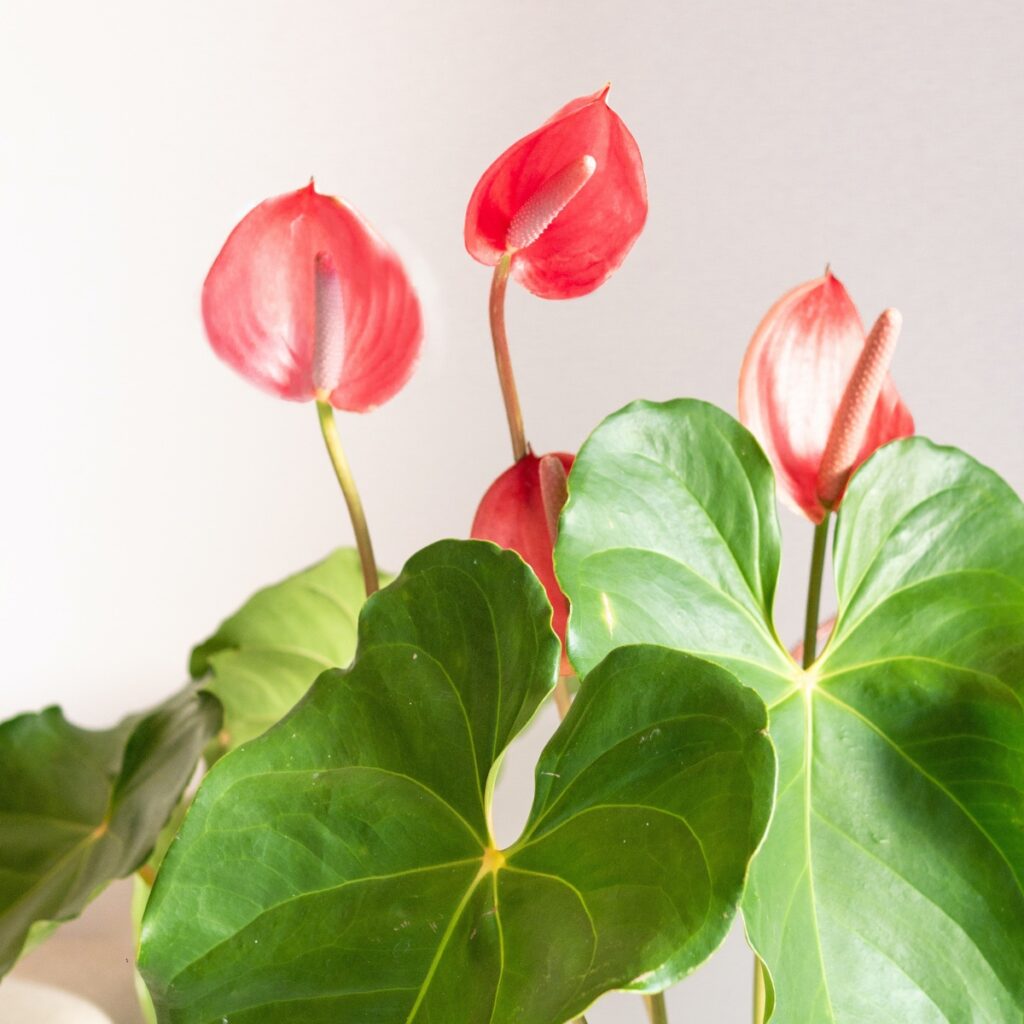
The Scientific Take on Growing Medium for Anthurium Andraeanum
The research aimed to identify the ideal growing medium for Anthurium andraeanum cv. Tropical. Various media combinations were tested, including coir pith, coconut husk, brick pieces, leaf mould, and farmyard manure (FYM). The study found that a 1:1 ratio of coir pith and coconut husk yielded the best results, promoting optimal plant growth, flower production, and improved flower quality.
Keep in mind that such studies primarily target large-scale horticultural cultivation of anthurium plants, and their recommended growing medium might not be the most suitable for indoor plants. It’s always wise (and fun!) to test and discover what’s working best in your home environment.
When and how to repot your flamingo plant
As a self-proclaimed anthurium addict, I’ve learned that anthuriums like to be root bound and should only be repotted when necessary. In my experience, signs that your anthurium flamingo needs repotting include roots circling the bottom of the pot or coming through drainage holes and a stiff pot that doesn’t squish.
If it has been a while since you have seen your anthurium flower, it might be a nutrient deficiency. Give it a fresh potting mix, and you might see it rebound.
Read my in-depth guide on repotting anthuriums to learn when and how to repot your flamingo plant.
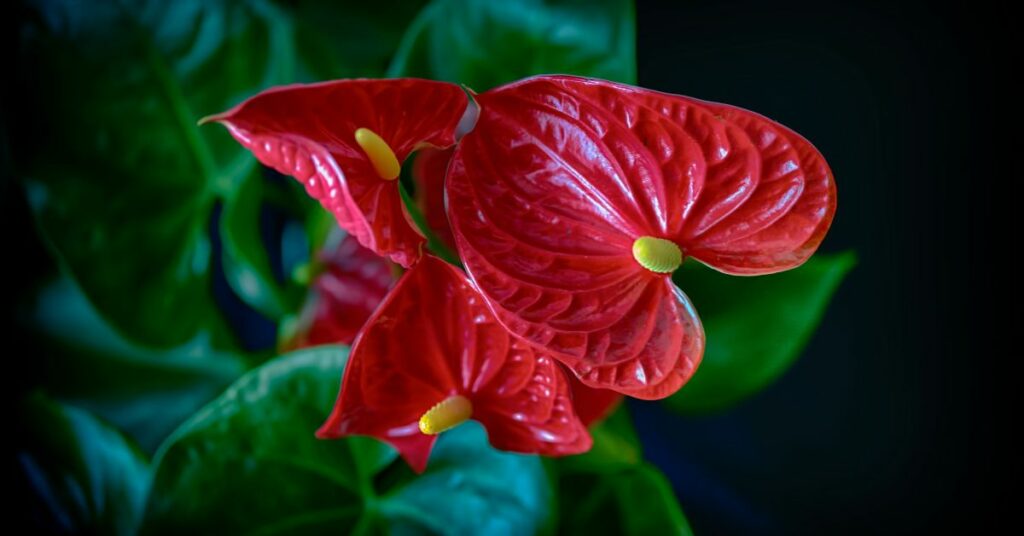
Tips on how to make your flamingo flower bloom
In my experience, light and fertilizer are the critical factors in making Anthurium andraeanum bloom. Here is the list of care tips that can promote flowering in order of importance (in my opinion).
- Provide bright indirect light: Ensure your flamingo flower receives the right amount of bright indirect light.
- Fertilize regularly: Feed your flamingo plant with a fertilizer high in phosphorus. This provides the necessary nutrients for blooming.
- Water consistently: Keep the soil consistently moist but not soggy. Water your flamingo flower when the potting mix feels dry, avoiding overwatering, which can lead to root rot. I have a helpful guide on anthurium watering, so check it out.
- Maintain proper humidity: Flamingo lilies are tropical plants that enjoy high humidity. Aim for a humidity level of 60-80%. You can increase humidity using a humidifier, but honestly, I don’t use a humidifier, and my ambient humidity is about 55%—the plant still blooms.
- Maintain optimal temperature: Flamingo flowers prefer temperatures between 65-85°F (18-29°C). Keep your plant away from cold drafts or direct heat sources to avoid temperature fluctuations.
Don’t be discouraged if your anthurium doesn’t bloom frequently. These plants are grown in highly controlled environments before they reach retail outlets and your home, with perfectly dialed light, fertilizer, water, humidity, and soil requirements.
It’s nearly impossible to replicate such conditions at home, so appreciate them while they appear and last, but don’t blame yourself if they are infrequent.
Some studies have investigated the effects of gibberellic acid on the yield of inflorescences, but the results remain inconclusive.
Anthurium Andraeanum Vs Anthurium Scherzerianum
Among the various Anthurium species, Anthurium scherzerianum is another anthurium that boasts inflorescences as striking as those of Anthurium andraeanum. These species share a notable similarity in their vibrant red blooms, setting them apart from other members of the genus.
Anthurium scherzerianum, unlike andraeanum, which is mostly grown for cut flowers, is primarily grown by aroid enthusiasts, mainly for its curly, pigtail-like spadix. Anthurium scherzerianum is found in Costa Rica at higher altitudes and is, therefore, more suitable to be grown as an indoor plant due to its tolerance for lower temperatures and lower humidity.
The two species have been attempted to be cross-pollinated many times but without success. Anthurium scherzerianum belongs to a different section, Porphyrochitonium. Some interesting crosses of Anthurium scherzerianum are with Anthurium wendlingeri, the strap leaf anthurium that also has a very characteristic spiral-like inflorescence.
The main differences between Anthurium Andraeanum and Scherzerianum:
Inflorescence shape
Anthurium scherzerianum is characterized by a curly, pigtail-like spadix (the central spike of small flowers), whereas Anthurium andraeanum has a straight, more elongated spadix.
Leaf shape
Anthurium scherzerianum usually has more elongated, lance-shaped leaves, while Anthurium andraeanum typically has broader, heart-shaped leaves.
Size
Anthurium scherzerianum tends to be smaller in size compared to Anthurium andraeanum. The latter often grows larger, with bigger leaves and a taller inflorescence.
Habitat
Anthurium scherzerianum is native to the rainforests of Costa Rica and Panama, while Anthurium andraeanum is indigenous to the rainforests of Colombia and Ecuador.
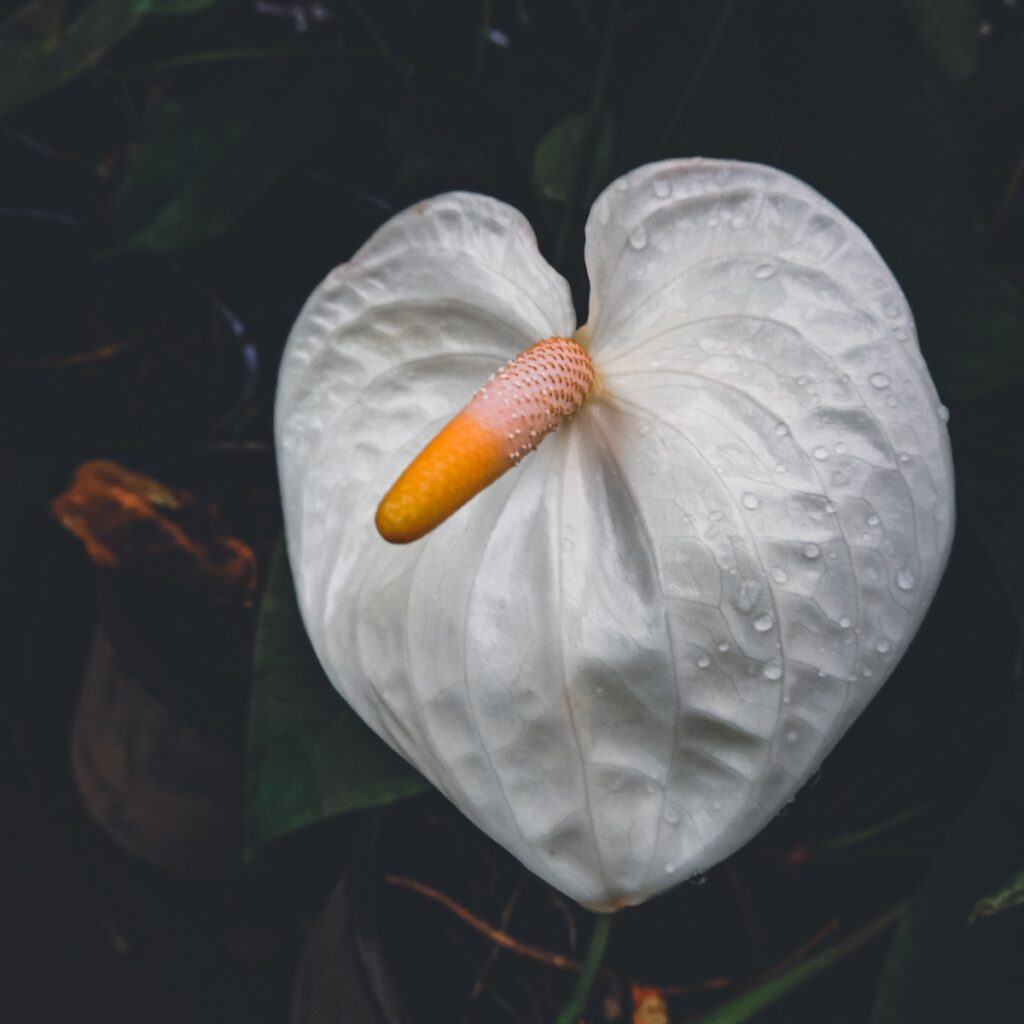
Cool facts & interesting info you won’t find easily
What’s senescence, and why it matters?
Did you know that senescence is a technical word describing Anthurium leaf aging? Aging is a problem for exporters as negative environmental conditions can affect the plants while shipping contributing to shorter vase life.
Hawaii’s Anthurium flowers, revered worldwide for their exceptional quality, face challenges maintaining their allure due to the long distances between the tropical paradise and its major markets.
However, breakthrough research on plant hormones and biotechnology offers new hope in extending these precious blossoms’ shelf life and overall productivity. By manipulating cytokinin levels, a natural plant hormone known for its anti-aging properties, scientists have achieved promising results in prolonging the life of Anthurium flowers and increasing their yield.
The next frontier involves introducing a gene controlling cytokinin production in Anthuriums, potentially increasing flower production by 1.3 to 1.5 times and extending vase life to an impressive 25-30 days.
The successful implementation of this technology promises to revolutionize the industry by reducing post-harvest losses, enhancing marketability, and lowering labor costs associated with preserving shelf life.
How long do anthuriums live?
This question usually refers to the longevity of cut flowers. With proper care and handling, the cut flowers from the most common varieties can have a two-week vase life. Some cultivars can live in water for several weeks.
How long does it take to produce a new cultivar of anthurium?
Did you know that Anthurium cultivar development by conventional breeding takes 10-14 years? That’s insanely long! The process involves cross-pollinating different Anthurium varieties, selecting offspring with desirable traits, and stabilizing these traits through successive generations.
Patience and persistence are essential, as it may require multiple generations to develop a stable, unique, and marketable new cultivar.
What’s an uncommon use for flamingo lily?
In some cultures, flamingo lilies are used in funeral floral arrangements, given their longevity and somber and dignified look.

